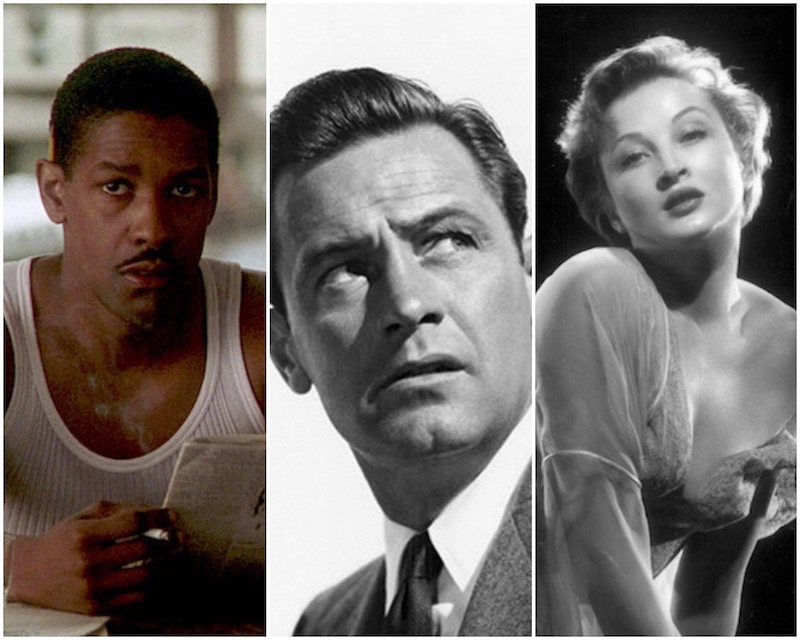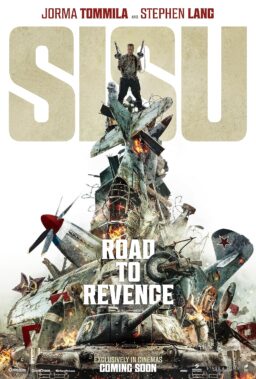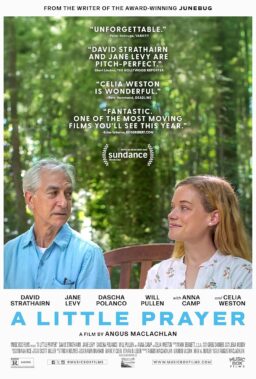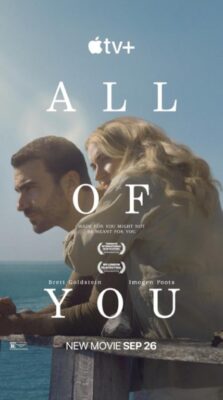This year’s Noir City: Chicago seemingly borrows a title from classic of the genre itself: Out of the Past.
For the 10th anniversary of the Chicago edition of their traveling festival, which runs August 17 to 23 at the Music Box Theatre, 3733 N. Southport, programmers Eddie Muller and Alan K. Rode have taken a page from the golden age of Hollywood. Each day of the weeklong event pairs two A and B titles for a double bill of maximum noir. (The term “B movie” of course was used to define films programmed as the lesser half of a double feature.)
“This year’s programming concept does seem really simple,” said Muller, founder and president of the San Francisco-based Film Noir Foundation, which presents the festival, with sponsorship from Turner Classic Movies’ weekly “Noir Alley” showcase (hosted by Muller, a.k.a. “The Czar of Noir” himself). He also will introduce films during the festival’s opening weekend at the Music Box. “The irony is that we’re doing what they were doing 70 years ago.”
Earlier this year, for the San Francisco edition of Noir City, Muller used the same concept, and “it was kind of revelatory,” he said. “It really focused my intros, and by programming this kind of double bills, we could address things that were different from year to year. By 1947-’48, noir was in full flower. It really wasn’t a movement until then. As it went forward, it changed and morphed into something different. It’s also a great way of balancing a well-known film with something more obscure that you couldn’t fit in otherwise.”
Rode, Muller’s partner in noirdom (and an FNF director-treasurer), reports the concept worked really well when they reprised it in Hollywood in April. “We had to cheat a bit to program ‘The Scarlet Hour’ (pictured below) since it’s a 1956 B-release paired with a 1952 A-title ‘The Turning Point.’” But they couldn’t resist because it’s a rarely seen noir by Hollywood heavyweight Michael Curtiz (the subject of Rode’s latest book, Michael Curtiz: A Life in Film, as well as a current retrospective at the Music Box).
“It’s exciting to show ‘The Scarlet Hour’ because it’s a real rarity,” said Rode, who will intro the second half of the Noir City lineup at the Music Box. Other than noir aficionados, “it’s sad that no one is interested in seeing films like this. We’re dealing with a generation who thinks Bill Murray in ‘Ghostbusters’ is a golden-age movie.”

In the past, all Noir City titles were shown in 35mm, but Muller and Rode have bowed to changing times. “If you want to hold out, you’re not going to be able to show certain titles,” Muller said. “‘The Scarlet Hour’ is a 35mm print from the archives. It might be the last one we ever get. In the future, we’re going to get them in digital restorations. That’s the way it is. But I would prefer to show a restored digital version of a film instead of being a stickler and insisting on a print that’s possibly worn out.”
Rode points out that Paramount quit making prints about seven years ago and other studios have followed suit. “I do have to say that some of the DCPs that Paramount has done are gorgeous,” he said. “They have that granular look, it doesn’t look artificial. If you want to see some of these films, DCP is going to be the medium of choice.”
This year’s festival kicks off with two ’90s neo-noirs directed by Carl Franklin, “One False Move” and “Devil in a Blue Dress.” “As much as I’m loyal to hard-core fans who want to see older, classic movies, I want to be able to take advantage of the moment,” Muller said. “It’s important to show that noir is not calcified. I see a natural extension from noir to current cinema. Plus, it’s interesting to see the African-American perspective on this genre.” Though he’s currently making a film in Pittsburgh, Franklin will appear opening night for post-screening discussions. “He’s willing to go the extra mile to be in Chicago for Noir City,” Muller said.
“For our 10th year in Chicago, it’s a terrific lineup and somewhat of a milestone,” Rode said. “It’s always great to come to the Music Box and continue relationships we’ve developed over the years. Even when the Cubs are playing, the Music Box is the place to be.”
Here’s the lineup of Noir City: Chicago 2018, with commentary by Muller and Rode:
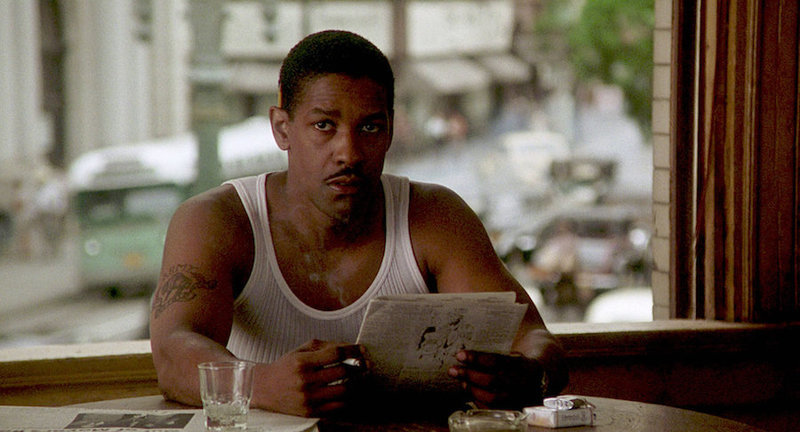
“Devil in a Blue Dress” (1995), Aug. 17, 7 p.m.: Based on the first book of Walter Mosley’s Easy Rawlins series, “Devil” follows a ’40s-era detective (Denzel Washington) assigned to find a society woman hiding out in L.A.’s black neighborhoods. “Modern updates of classic noir typically don’t do well,” Muller said. “Hollywood thought ‘L.A. Confidential’ was a flop. The same with this title. However, it features Denzel at his most sexy and most movie star-ish.”
“One False Move” (1992), Aug. 17, 9:45 p.m.: Muller calls Carl Franklin’s breakthrough movie, about a hayseed cop (Bill Paxton) trying to root out a gang of killers, “one of the great crime films ever made. We’re showing it second, because it’s hard to watch. People might walk out because of the violence, the first scene is really intense. Also, it’s a good way to salute Bill Paxton”—who died last year at age 61. “His death didn’t really register. It’s one thing when it’s Tab Hunter [who died three days shy of his 87th birthday in July] but when it’s someone as young as Bill—that’s tragic. Noir City revives golden-age movies that people have missed, and now that applies to films from the ’80s and ’90s as well. Billy Bob Thornton co-wrote the script, and its race-related themes are still timely 25 years later.” To read Peter Sobczynski’s interview with director Carl Franklin about “Devil in a Blue Dress” and “One False Move,” click here
“Conflict” (1945), Aug. 18, 3 p.m.: Reverting to his heavy roles after his transformation as a romantic hero in “Casablanca” (1942), Humphrey Bogart plays a murderous husband with designs on his wife’s sister. Rode regards “Conflict” as “one of Bogie’s most overlooked films,” in part because the title was shelved for two years over a rights issue.
“Bogie hated making the movie, it was too close to his own life,” Muller said, referring to the actor’s rocky relationship with third wife Mayo Methot. “‘Conflict’ was Jack Warner’s payback.” Instead of cashing in on the star’s new appeal, the studio chief “wanted to stick it to Bogie” to show him who still remained the boss,” Muller said. “But his plan backfired, because after “Casablanca,” “the public didn’t want Bogie to be a bad guy anymore.”
“Escape in the Fog” (1945), Aug. 18, 5 p.m.: For the watershed noir year of 1945, “we had a lot of movies to choose from,” Muller said of this thriller about an Army nurse (Nina Foch) terrified by a recurring dream in which she witnesses a murder on the Golden Gate Bridge. “But ‘Escape in the Fog”—it’s Budd Boetticher,” referring to the Chicago-born director, best known for his seminal Westerns of the ’50s. “It’s great to see something early from him. I love to show films by directors who are going on to bigger things … and it’s from Columbia, which always supplies us gorgeous 35mm prints.”

“The Blue Dahlia” (1946), Aug. 18, 7 p.m.: This classic noir, penned by Chicago-born crime-fiction icon Raymond Chandler, gives Alan Ladd one of his signature roles as a returning soldier accused of murdering his unfaithful wife (Doris Dowling). It reteams Ladd with Veronica Lake, after their successes as Paramount’s leading romantic duo in “This Gun for Hire” (1942) and “The Glass Key” (1942).
Muller finds it mystifying that Ladd has been virtually forgotten by modern audiences, unlike fellow noir heroes Bogart and Robert Mitchum, and that Lake continues to be dismissed as a mere vamp (albeit with a stylin’ hairdo). “People had such a wrong notion of what she was on screen,” he said. “She was not a femme fatale. Lake was brainy and didn’t need the guy. ‘The Blue Dahlia’ is a classic example of that. I don’t like the idea that women were sexy dames just out to corrupt men. Plus, her films projected a very significant image during the war for American women.”
“Strange Impersonation” (1946), Aug. 18, 9:15 p.m.: Beset by blackmail, a scheming assistant, a disfiguring accident and romantic betrayal, a research scientist (Brenda Marshall) plots her revenge. “I have a soft spot for B movies that make absolutely no sense,” Muller said of this pivotal early film by director Anthony Mann. “I love the ones where there’s some sort of weird science in a crime film. And this film is right in that sweet spot.”
Rode calls “Strange Impersonation” “one of most bizarre movies ever made … it’s 68 minutes of real weirdness absolutely not to be missed.”
“The Unsuspected” (1947), Aug. 19, 2 p.m.: After the secretary of a radio personality (Claude Rains) turns up dead, he hints at murder. “This film marks Michael Curtiz’s first production away from Warner Bros [his longtime studio home],” Rode said. “He was trying to do something similar to ‘Laura,’ but didn’t turn out that way. Claude Rains is great and gives the perspective of the role that radio that played in pop culture back then. Plus, the camera work by Curtiz and cinematographer Woody Bredell is something to behold.”
Muller added, “I’m always on lookout for noir written by women. The Charlotte Armstrong novel [adapted by Bess Meredyth and Ranald MacDougall] is really good. ‘The Unsuspected’ is just juicy, it doesn’t make a lot of sense, but with a cast like Claude Rains and Audrey Totter, it doesn’t have to.”

“Blind Spot” (1947), Aug. 19, 4:15 p.m.: Of this fast and furiously paced B, Muller observed: “It’s a very cleverly written film about cleverly written stories … a very smart and savvy commentary on literary vs. genre fiction.” Chester Morris, best known for the “Boston Blackie” series, plays a down-on-his-luck writer who pens a murder mystery to show how easy it is, “and then he blacks out and can’t recall the ending, and he’s the prime suspect.”
Muller also applauds the performance of Constance Dowling (older sister of Doris) as a secretary/dangerous blonde. “Look her up on the internet,” he said. “She became Elia Kazan’s mistress, then her next lover committed suicide over her. She’s quite beguiling on screen.”
“I Walk Alone” (1948), Aug. 19, 6:15 p.m.: After a 14-year stretch in the slam, a Prohibition-era bootlegger (Burt Lancaster) discovers his former partner (Kirk Douglas) has no intention of sharing the profits of their previous spoils. “It’s a great cast, with Burt and Kirk in the first of the seven films they made together, along with the always amazing Lizabeth Scott—a star fest in a cool Hal Wallis production,” Muller said.
Its source elements once considered lost, “I Walk Alone” has been restored by Paramount and will be shown in DCP format. “I’m happy my relationship with studios leads to these kinds of rediscoveries,” Muller said. “The Film Noir Foundation is the impetus for a studio like Paramount to find the original elements, do a digital scan and then create a new DCP. Kino will release the film in a Blu-ray edition this fall. All of this resulted because of me being a pain in the ass all these years.”
“Bodyguard” (1948), Aug. 19, 8:30 p.m.: After getting bounced for insubordination, a homicide detective (Lawrence Tierney) takes a job in a meat-packing plant where an inspector has been ground up along with the product. “It’s one of [director] Richard Fleischer’s down and dirty noirs,” Rode said. “He didn’t truly move into the noir groove until ‘Narrow Margin,’” referring to the director’s 1952 classic noir on a train. “Plus, it stars Tierney, the meanest man in film noir. And one of the writing credits is by Robert Altman, then just 23.”
“Lawrence Tierney, what can I say?” Muller said. “‘Bodyguard’ is great, terrific and so entertaining. I stay in the theater and watch it every time because Tierney is always so intriguing on the screen.”

“All My Sons” (1949), Aug. 20, 7 p.m.: Muller and Rode admit that this film version of Arthur Miller’s Tony Award-winning drama about an ethically challenged businessman (Edward G. Robinson) and the failure of the American dream is “not really noir but noir-stained.” They both believe in stretching the boundaries of noir when appropriate. “Plus, its theme about a guy profiting from war and the guilt he faces over manufacturing defective parts has resonance to this day.”
Rode observes that “All My Sons” is another completely overlooked film—it’s not on DVD, not available on streaming platforms. Robinson gives one of his great performances opposite Burt Lancaster [as one of Robinson’s sons]. They’re both so good, and the film features lots of great character actors, including Harry Morgan and Lloyd Gough.”
“The Spiritualist” (1949), Aug. 20, 9:15 p.m.: A shady medium (Turhan Bey) persuades a widow that he can communicate with her late husband in what Muller and Rode consider an underappreciated gem from master cinematographer John Alton, who virtually invented the look of film noir in the ’40s. “Again, it’s as good as B movies get,” Muller said of this Eagle-Lion programmer also known as “The Amazing Mr. X.” “John Alton’s one of my faves—it’s more his movie than the director [Bernard Vorhaus]. You can tell that Alton is calling the shots. I showed it years ago, and Bey showed up, and that’s what he said, too. He told story after story about what a genius Alton was, dictating the whole day’s shoots according to his lighting scheme.”
Rode also recalls that 2000 screening in Los Angeles of “The Spiritualist,” when Bey appeared unexpectedly: “No one knew he was. He asked, ‘Where are all the great character actors I used to work with?’ Very sweet guy. The only print we had was a bad one with splices, and the film broke three times.”
“The Man Who Cheated Himself” (1950), Aug. 21, 7 p.m.: A veteran homicide detective (Lee J. Cobb) involved with a married socialite (Jane Wyatt) covers up a murder and then discovers that his rookie brother (John Dall) has been assigned to the case. Muller claims Felix E. Feist’s crime drama has “the weirdest casting ever in a noir.”
Rode agrees: “Lee J. Cobb finally, just off his breakthrough role on Broadway in ‘Death of a Salesman,’ finally plays someone his own age, this time as a horn-dog detective, opposite Wyatt, usually the paragon of virtue.” Shot on location in San Francisco, “it’s really worthwhile.”
At the Music Box, “The Man Who Cheated Himself” will be shown in a restored 35mm print, funded by the Film Noir Foundation and the UCLA Film & Television Archive.

“I Was a Shoplifter” (1950), Aug. 21, 9 p.m.: This programmer about an undercover cop (Scott Brady) and a five-finger discount ring is a real rarity, and even more remarkable, Muller reports he has never seen it: “We realized in it was in Universal’s archives; Alan swears it’s worthwhile. There are films I consciously don’t watch because I’m saving them. When I’m 75, I want to have films to look forward to.”
Rode confirms the movie’s bona fides. “It stars Scott Brady, the good brother of Tierney family,” he said of the actor, the middle sibling of the Tierney acting clan. “They were on completely different sides of the spectrum in most movies.” Shot on location in Los Angeles and San Diego, “I Was a Shoplifter” features Rock Hudson, Peggie Castle and James Best in bit roles, and Tony Curtis as a sinister sidekick improbably named Pepe.
“The People Against O’Hara” (1951), Aug. 22, 7 p.m.: In his only film noir, Spencer Tracy plays an alcoholic attorney who comes out of retirement to defend a neighbor’s son (James Arness, later of “Gunsmoke” fame) against a homicide charge. “Tracy’s character cuts close to the bone,” Rode said of this film, directed by Oak Park native John Sturges, best known for his epic actioners such as “The Magnificent Seven” (1960) and “The Great Escape” (1963).
Muller again lauds the camerawork of John Alton: “one of the many Hungarians who transformed Hollywood. His career completely coincided with the rise of noir. After 1947, he was the go-to guy for the genre.”
“Pickup” (1951), Aug. 22, 9:15 p.m.: Of this lurid potboiler about an older man duped by a femme fatale, Rode said, “the moment this one starts, you know you’re not talking about a truck.” Beverly Michaels, the film’s deadly dame, was married to Russell Rouse, author of the classic noir “D.O.A.” (1949), in real life. Their son is Oscar-winning editor Christopher Rouse (“The Bourne Ultimatum”). “I once asked him how it was like growing up in a noir nuclear family,” Rode said. Meanwhile, “Hugo Haas spent his career making bad remakes of ‘The Postman Rings Twice,’ with an older man being tormented by a younger woman.” And in “Pickup,” Haas plays the beleaguered husband (named Jan “Hunky” Horak) himself.
Once reviled as “the foreign Ed Wood,” Haas deserves more respect. “I find his movies hugely entertaining, and fans go nuts for them,” Muller said. “I love his backstory. He was an esteemed actor in Moravia [now part of the Czech Republic]. When he came to the U.S., his compatriots were embittered by their lower status, but he wasn’t afraid to embrace the low-budget mystique. All of his films made money, and he worked with fabulous actresses. His formula was absolutely flawless. I have nothing but admiration for Hugo Haas.”
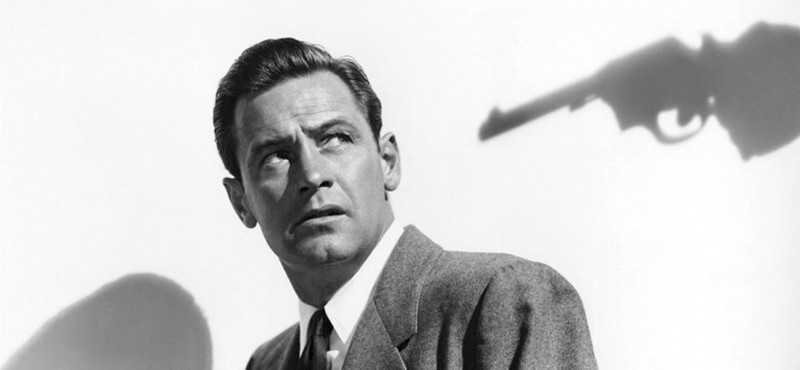
“The Turning Point” (1952), Aug. 23, 7 p.m.: When a reporter (William Holden) and a prosecutor (Edmond O’Brien) investigate a crime syndicate, they discover a family member might be on the take. “It’s a great cast, with a panoply of character actors,” Rode said. “When Ted de Corsia [known for his many villainous roles] plays a voice of reason, you know it’s serious.”
A riff on the Kefauver Commission probe into organized crime in the early ’50s, “The Turning Point” was filmed on location in Los Angeles, with scenes set at iconic spots such as Angel’s Flight and the Bunker Hill neighborhood. It was directed by German emigré William Dieterle, who notched up a few noirs in his extensive filmography. “I think he’s underrated, he was a protege of Curtiz’s,” Rode said. “It’s not just a crime expose, there’s a definite noir element.”
Muller notes that the Film Noir Foundation had pursued this Paramount release for years and finally persuaded the studio to restore the title, which be shown in the DCP format. “It’s much like ‘I Walk Alone.’ I thank Paramount for rescuing it,” he said. “How did this movie slip through the cracks? I think this film will surprise, because it’s much darker and bleak than people realize.”
“The Scarlet Hour” (1956), Aug. 23, 9 p.m.: Michael Curtiz’s thriller pits an adulterous pair (newcomers Carol Ohmart and Tom Tryon) against a possessive husband (James Gregory), with a jewel robbery as the lovers’ method of deliverance. “It’s a little over the top, but it’s perfect for what it is in this festival,” Muller said. “This crime drama has so many elements of film noir, but you can see everything changing. It’s such a rarity; I’m so proud finally able to get this film,” which will be shown in an archival 35mm print. “Paramount doesn’t do that anymore—ship an archival print from the vault.”
Rode reminds noir fans that “The Scarlet Hour” is not available on DVD or streaming platforms. “It’s terrible but somehow terrific,” he said. “It was Curtiz’s last chance. He was old and had made several bad movies. This was his opportunity to capitalize on his reputation as a star marker—but Tom Tryon and Carol Ohmart? It didn’t work out, but the movie is often compared to ‘The Postman Always Rings Twice.’ Carol comes across as a really feral fatale.”
Shot all over Los Angeles, “The Scarlet Hour” features a great supporting cast, with E.G. Marshall, Edward Binns and Elaine Stritch in her film debut. Plus, there’s a scene with Nat King Cole singing at Crystal Ballroom at the Beverly Hills Hotel. “Curtiz might have been an SOB, but he was ‘Casablanca,’” Rode said. “We always have that.”
Festival passes are $85 apiece ($75 for Music Box members). Opening-night tickets, $12 ($9 for members). Single-feature tickets, $11 ($7, members). Double-feature tickets, $15 ($12, members). For more information about Noir City: Chicago, click here
